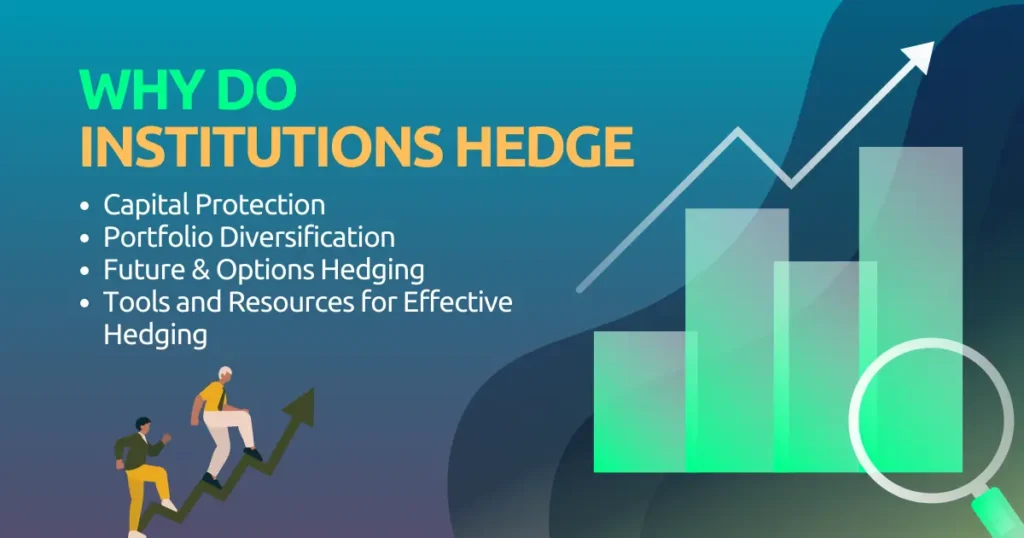
FII and DII Hedging Techniques
Introduction: The stock market is a complex sector, where large investors such as foreign institutional investors (FII) and domestic institutional investors (DII) play a key role in setting market trends. But how do these institutional investors manage risks in a volatile market? The answer lies in hedging techniques.
At Index Hedger, we aim to help traders and investors understand and leverage hedging strategies. In this post, we will discuss how FII and DII hedge their investments, and how retail investors can learn from these techniques to protect their portfolios.
Difference between FII and DII
To understand their hedging techniques, we first need to clarify the key difference between FIIs and DIIs:
Foreign institutional investors (FII) are investment funds or companies that invest in stocks, bonds, and other financial assets in markets outside their country. For example, a large US-based hedge fund investing in Indian stocks is considered an FII. Their decisions have a huge impact on stock prices, currency fluctuations, and overall market sentiment.
Domestic Institutional Investors (DIIs) are institutional investors such as mutual funds, insurance companies, and pension funds that invest in their domestic market. In India, DIIs such as the Life Insurance Corporation (LIC) or mutual funds help stabilise the market, especially when FIIs move their funds in and out of the country.
FIIs and DIIs contribute significantly to market movements, and their investment strategies, especially hedging, affect not only institutional portfolios but also retail investors.
Hedging is a way to manage risk. It allows FIIs and DIIs to protect their portfolios from adverse price movements in stocks, bonds, and other financial assets.
Here is why hedging is necessary for them:
Market volatility: Stock markets are unpredictable. Factors such as global economic conditions, geopolitical tensions or currency fluctuations can trigger extreme price movements.
Currency Risk: FIIs investing in foreign markets are exposed to currency risk. For example, a US investor investing in Indian stocks is affected by both stock price fluctuations and USD/INR currency movements.
Portfolio Protection: DIIs, especially those handling retirement funds or insurance policies, need to ensure the safety of long-term investments.
Both FIIs and DIIs use various hedging strategies to protect their portfolios from these risks, ensuring that their returns are protected even in uncertain market conditions.
Common Hedging Techniques Used by FIIs
FIIs are usually exposed to global market risks, and here are some of the key hedging strategies they use to protect their investments.
- Currency Hedging: Since FIIs are exposed to foreign exchange fluctuations, they use currency futures and options to protect themselves from sharp currency movements. For example, if the Indian rupee weakens against the US dollar, it can reduce FIIs’ returns, so they hedge their currency risk by using derivatives.
- Index futures: FIIs often hedge their broad market risk by using index futures such as Nifty or Sensex futures. By shorting index futures, they can protect themselves from overall market declines while holding individual stocks they think will outperform.
- Global derivatives: FIIs also use advanced instruments such as equity swaps, commodity derivatives and interest rate swaps in global markets to hedge their diversified portfolios. This helps them mitigate risks arising from global events such as trade wars or changes in interest rates.
Common hedging techniques used by DIIs
DIIs, primarily focused on the domestic market, use a variety of strategies to manage their risk exposure.
Here are some most common strategy:
- Sectoral hedging: DIIs often hedge their exposure to specific sectors that are more volatile. For example, if DIIs have significant exposure to the banking sector, they may use sector-specific index futures or options to hedge against any downturn in that sector.
- Stock futures and options: DIIs also hedge individual stock positions using stock futures and options. If they hold a large position in a stock such as Reliance, they may buy put options to protect themselves against any potential decline in its price.
- Bond portfolio hedging: Many DIIs, such as insurance companies and pension funds, hold large portfolios of bonds. To hedge interest rate risk (the risk that rising interest rates will cause bond prices to decline), DIIs use instruments such as interest rate swaps or bond futures.
Differences Between FII and DII Hedging Strategies
While both FIIs and DIIs hedge to manage risks, their strategies differ due to their different risk exposures:
- Global vs. Domestic Risks: FIIs focus on hedging currency and global market risks. DIIs, on the other hand, are more concerned with domestic factors such as regional performance and interest rates.
- Instruments Used: FIIs often use a more diverse set of instruments, including international derivatives, while DIIs primarily use local market instruments such as stock and index futures.
For example, an FII might hedge its currency exposure in the USD/INR market, while a DII might hedge its exposure to Indian banking stocks using options on the Nifty Bank Index.
Impact of FII and DII hedging on retail investors
FII and DII hedging activities often impact market trends and retail investors should be aware of these impacts:
- Market sentiment: Large-scale hedging by FIIs or DIIs can change market sentiment. If FIIs start selling futures to hedge, it may signal to retail investors that the market may face a correction.
- Learning from institutions: Retail investors can adopt some of the basic hedging techniques used by FIIs and DIIs, such as buying protective put options or using futures to lock in prices for key stocks in their portfolios.
- Proceed with caution: Retail investors should remember that while hedging can protect against losses, it also comes with its own risks, such as the cost of buying options or potential losses on futures contracts.
Practical example of FII and DII hedging: Let us look at a recent scenario where hedging played a key role. In early 2023, FIIs were seen reducing their exposure to Indian equities due to fears of a global recession. To protect their portfolios, they shorted Nifty futures while retaining their stock positions. At the same time, DIIs continued to invest in Indian markets with a more long-term view but hedged their positions with sector-specific options.
This example shows how FIIs and DIIs use hedging not only to manage risk but also to take advantage of market opportunities without exiting their stock positions.
Conclusion
Understanding the hedging techniques of FIIs and DIIs can give retail investors valuable insights into risk management. While these institutional players use advanced tools but the principles of protecting investments apply to all investors.
By learning from their strategies, you can make more informed decisions, especially in volatile market conditions. Hedging can protect your portfolio and help you achieve your long-term financial goals.
Frequently Asked Questions:
FII (Foreign Institutional Investors) refers to investors or funds from outside the country that invest in domestic financial markets. DII (Domestic Institutional Investors) are entities like mutual funds or insurance companies that invest in the stock market within their country.
FII and DII use hedging techniques to protect their investments from market risks such as volatility, currency fluctuations, and economic instability. Hedging helps them minimise potential losses while maintaining their position in the stock market
Currency hedging is a strategy that FIIs use to protect their investments from adverse exchange rate movements. Since FIIs deal in foreign currencies, changes in exchange rates can affect their returns. Currency hedging reduces this risk by locking in a specific exchange rate.
DIIs commonly use sectoral hedging, stock futures and options, and interest rate swaps to protect their investments. These techniques help DIIs manage risks associated with domestic market volatility, interest rate changes, and declines in a specific sector.
FII and DII hedging can influence market sentiment and prices. If FIIs hedge by shorting index futures, it could be a sign of a bearish trend, which could lead to a decline in prices. Retail investors can take advantage by tracking these moves and adjusting their strategies.
FIIs focus on hedging global risks such as currency fluctuations and international market risk, while DIIs focus on domestic risks such as sector-specific recessions or interest rate changes. The instruments they use also differ, with FIIs relying on global derivatives and DIIs primarily using local market instruments.
Yes, retail investors can adopt the same hedging techniques such as buying protective options or using stock futures, but they should be careful. Hedging can be complex and involve costs, so it is important to fully understand the risks before implementing these strategies.
FIIs use index futures to hedge their broad market exposure. By shorting index futures (such as Nifty or Sensex futures), they protect their portfolios from overall market declines, while still holding individual stocks they think will outperform.
Sectoral hedging involves using derivatives to protect investments in specific sectors (such as banking or IT). DIIs use sectoral hedging to manage risks when there is significant exposure to a particular industry, thereby protecting their portfolios from a downturn in that sector.
Understanding FII and DII hedging techniques can help retail investors better understand market risks and improve their portfolio management. By following institutional investor strategies, retail investors can make more informed decisions about when to hedge their own investments and minimise potential losses.
Retail investors can use the same hedging strategies, such as options and futures, but they typically lack the resources and expertise available to larger institutions. Additionally, some advanced hedging tools are only accessible to institutional investors.

